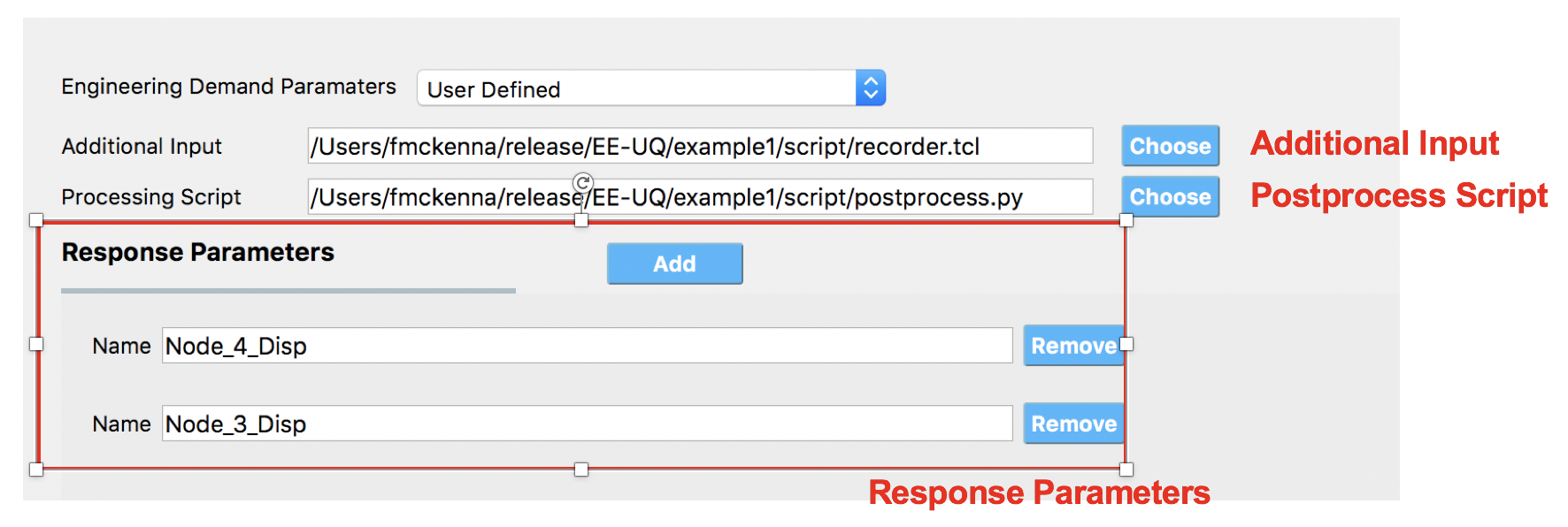2.6. EDP: Demand Parameters¶
This panel is where the user selects which outputs will be displayed when the simulation runs. There are several options available in the pull-down.
Standard
User Defined
2.6.1. Standard¶
When the user selects this option, there are no additional inputs required. The standard EDP generator will ensure the max absolute value of the following is obtained:
Relative Floor displacements:
Absolute Floor Accelerations
Interstory Drifts
The results will contain results for these in abbreviated form:
PFD peak relative floor displacement Event#-PFD-FLOOR-CLINE
PFA peak floor acceleration Event#-PFA-FLOOR-CLINE
PID peak inter-story drift: Event#-PID-STORY-CLINE
Note
Floors are numbered starting at floor 0, and stories are numbered starting at story 1.
2.6.2. User Defined¶
As shown in Fig. 2.6.2.1, this panel allows users to determine their own output and process it. When using this option, the user provides additional data:

Fig. 2.6.2.1 User Defined EDP panel.¶
Additional Input: These are additional commands invoked by the analysis application before the transient analysis is performed. For example, for OpenSees, this would be a script containing a series of recorder commands. A recorder file passed to OpenSees might look like the following:
recorder EnvelopeNode -file node.out -node 1 2 3 4 -dof 1 disp recorder EnvelopeElement -file ele.out -ele 1 2 3 forces
Postprocess Script: This is a python or Tcl script invoked after the finite element application has run. It must be provided by the user. Its purpose is to process the output files and create a single file, namely results.out. This file must contain a single line with as many entries as EDP’s specified.
For example, a python postprocessing file that would take the outputs from the recorder commands of the previous code block to create the results file needed by the applications might look like the following:
A Tcl file might look like the following:
set nodeIn [open node.out r]
while { [gets $nodeIn data] >= 0 } {
set maxDisplacement $data
}
puts $maxDisplacement
# create file handler to write results to output & list into which we will put results
set resultFile [open results.out w]
set results []
# for each quanity in list of QoI passed
# - get nodeTag
# - get nodal displacement if valid node, output 0.0 if not
# - for valid node output displacement, note if dof not provided output 1'st dof
foreach edp $listQoI {
set splitEDP [split $edp "_"]
set nodeTag [lindex $splitEDP 1]
if {[llength $splitEDP] == 3} {
set dof 1
} else {
set dof [lindex $splitEDP 3]
}
set nodeDisp [lindex $maxDisplacement [expr (($nodeTag-1)*2)+$dof-1]]
lappend results $nodeDisp
}
Warning
The name of the output file must be results.out.
Response Parameters. This is an area in which the user
associates a variable name with the column of the results output file. If the process script has an array of strings named named EDP’s the script, the Response Parameters will be initially set with these values from the script.